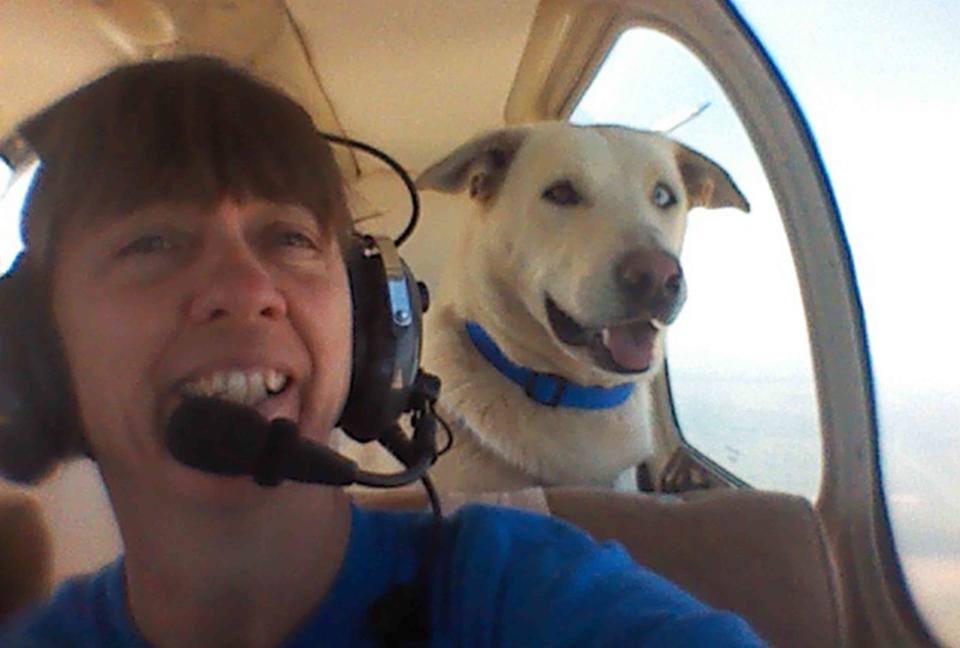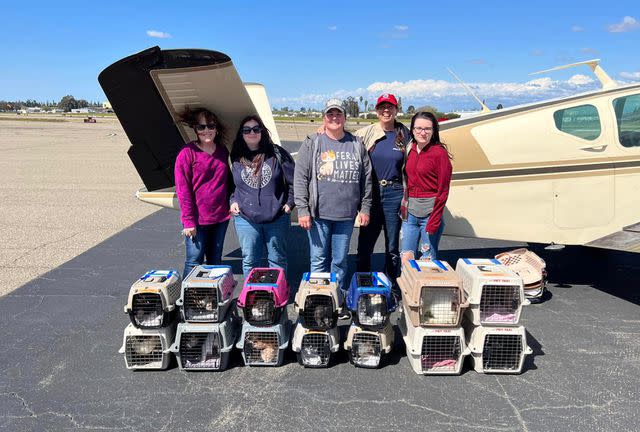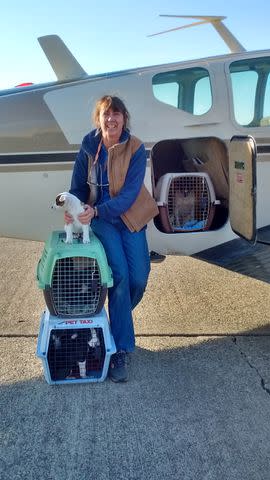This Pilot Has Flown Some 100,000 Miles to Save Shelter Pets
Before adoption, some dogs enjoy a flight with volunteer pilot Kim Purcell.

Kim Purcell
Not all heroes wear capes, but some of them are able to fly.
Kim Purcell has volunteered for Pilots N Paws (PNP) since August 2009 after coming across the nonprofit on social media. To date, she’s transported over 1,500 animals from overcrowded shelters—where pets are often at risk of euthanasia—to roomier shelters and, ultimately, adoption.
Purcell estimates she’s flown about 80,000 to 100,000 miles in the 14 years she’s volunteered with PNP. Her longest flight? Around 600 miles. The most animals on her aircraft? That would be 72 cats—mothers and kittens—from Fresno to Napa.
“There is no better feeling than helping to save these amazing animals, especially when they're coming from high-kill shelters or high-kill areas,” Purcell says.
She commuted to work via plane as a paramedic in San Francisco while living in the hills outside Placerville, California—about a two-hour drive from the Bay Area. After retiring, she needed reasons to fly more in her 1957 Beechcraft H35 Bonanza and 1950 Cessna 170A.
Purcell flies out of Fresno, where she'd met a group of devoted women working tirelessly to help countless dogs and cats in an environment of overpopulation, lack of care, and overcrowded shelters. It's hard work fighting a crisis.
The Transport Process at Pilots N Paws
In addition to flying, Purcell coordinates flights for the rescues, determining which aircraft can fulfill each airlift's space needs. She also educates pilots on transporting newborn puppies and kittens, keeping animals comfortable in hot or cold weather and employing proper health and safety measures.
A normal transport starts with rescues and shelters posting to the Pilots N Paws forum. Pilots check the board and volunteer to take on trips. When she flies, Purcell determines how many animals will be transported so she can then allocate the number (and sizes) of crates she’ll need.

Kim Purcell
From there, the departing and intaking shelters schedule a weather-dependent time and date. If the flight crosses state lines, a health certificate may be needed.
Upon arriving at the pick-up point, Purcell assesses how she’ll load the aircraft. If she’s transferring animals into her crates, she always uses antiviral wipes in between handling animals to assure no unknown illnesses spread.
If it’s hot out, Purcell will bring frozen water bottles to add to each crate under the towels she places in each. Then she tries to be as efficient as possible once loaded. The plane heats up quickly, so she also keeps the doors open to circulate as much air as possible until takeoff.
When flying, Purcell keeps climbs and descents to a maximum of 500 feet per minute as much as possible. If she’s transporting newborn or very young puppies or kittens, she decreases to 200 feet per minute after the initial climb.
Purcell always brings another person with her to monitor the animals in the air and regulate the plane's temperature when able. Once everyone has been dropped off at the rescue, she returns home to unload and clean all the crates and towels.
Making an Impact
Purcell has flown dogs, cats, ducks, and even a pig. She even volunteered to fly a bobcat and a bear, but other pilots drew those assignments.
"If they can fit in the aircraft, we'll transport them,” she says.
For the last four years, Purcell has primarily flown cats—though she still flies dogs, sometimes on the same flights as cats—and coordinates with other pilots for many of the dog transports. Because she’s collected a large selection of crates over the years and knows how to Tetris them into her aircraft, she can transport more animals than the inexperienced and, thus, save more lives.

Kim Purcell
“So many shelters are overcrowded, so transporting to other areas with higher adoption rates saves them from being euthanized,” Purcell says. “Flying is so much faster than driving, which results in less stress on both dogs and cats. Once in the air, they almost always settle down and enjoy the ride.”
While she has many favorite trips, one that stands out to her is flying a special needs kitten, Gilbert, with cerebral hypoplasia from Jackson to Santa Rosa’s Special Needs Are Precious (SNAP) Cats. He insisted on being held during the flight, and Purcell even visited him a few times at SNAP Cats before he was adopted.
She later adopted two cats of her own from SNAP Cats.
Why She Flies
Purcell grew up in an airplane, first hitting the sky at just three days old. Her father was a pilot and highly involved in the local pilots group. She and her family took trips nearly every weekend in their plane.
But she soon wanted nothing to do with flying after her father died in a plane crash when she was 12. She didn't return to the sky until she was in college. She wanted the challenge of providing medical aid in the air, so she became driven to get her license to fly. (Indeed, she later worked as a flight medic.)
Purcell's life has come full circle. She discovered via log books that her Bonanza once belonged to her father’s best friend. She rode in the back seat of this plane as a kid. It's fitting: Her father and his best friend were both pilots and animal lovers.
Helping save innocent animals' lives is the most rewarding part about what she does.
“I’ve always had and rescued animals, so this was a perfect fit for me, and my background in medicine has been an asset with some of the shelter rescues who were not healthy,” Purcell says.
When she's not in the air, she'll spread the word, appearing at airshows and airport days. She educates community members about what the volunteer pilots do at PNP and the need to spay and neuter to address shelter overpopulation. She also talks to other pilots about PNP, and although many have still never heard of it, she lets them know how they can participate.
In fact, here's where you can join her.
Read the original article on The Spruce Pets.

